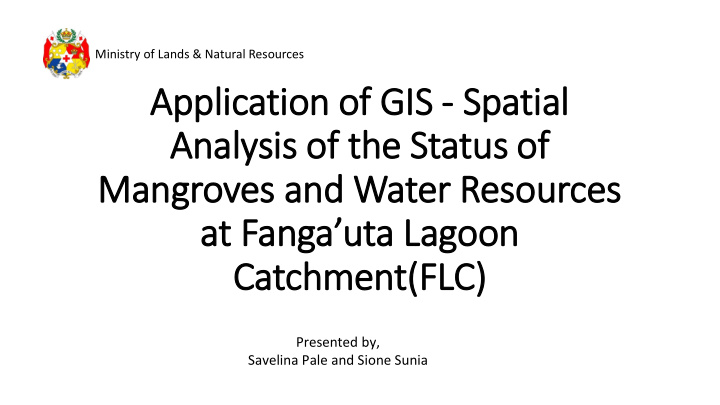



Ministry of Lands & Natural Resources Application of GIS IS - Spatial Analysis of the Status of Mangroves and Water Resources at Fanga’uta Lagoon Catchment(FLC) Presented by, Savelina Pale and Sione Sunia
Fanga’uta Lagoon Catchment Nuku’alofa (F (FLC) • Located on the main Island of Tongatapu • FLC – area within the yellow line
Ministry of Lands & Natural Resources Aim • Using GIS based system to spatially analyse and visualise the status of FLC ecosystem goods and services, to support informed decision making on sustaining Mangroves and Water Resources in the FLC
Ministry of Lands & Natural Resources Obje jectives • Use GIS based system to monitor and analyse the status of water quality in Water Springs and Well bores within the FLC. • Use GIS based system to monitor and analyse the status of mangrove ecosystem(carbon sink) at Fanga’uta lagoon Catchments
BACKGROUND OF FLC • FLC is a R2R Project • 64% of Total Population • 31% of Total Land Area • 29 Villages • Importance to the wellbeing and livelihood of communities • Last monitoring in 2001 under the TEMPP
Population Density of FLC • FLC Comparison of 2006 – 2016 • Steady but estimated to increase in years to come
Stakeholders • Donors (UNDP, GEF) • Line Ministries ( Statistics, Environment, Waste Authority, Health, Ministry of Lands & Natural Resources etc.) • NGOs (Civil Society, Geo-recycling) • Communities (Town officers, Residents)
Ministry of Lands & Natural Resources FINDINGS IN THE FANGA’UTA LAGOON CATCHMENT
Water Quality Detemined by measure of • Salinity of water • Water depth • Temperature • Faecal Coliform (Bacteria count) • Nitrate • Nitrite • Phosphate • Ammonia Conductivity were measure Using Solonist Faecal Coliforms using reagents In the water lab Green point – Spring Water Red point – Well Bores
Topographical Relief of FLC • Fresh Water Discharge
Conductivity • Micro – Siemens 0 – 5000+
Coliform Counts from Springs and Wells
Groundwater • Depth to water level (m) 0.0 - 50
Mangrove 2006 3 Sectors showing the loss of Mangroves. • Popua • Hoi • Nuku • Approximately 417.69 ha of Mangrove at site
Mangrove 2015 Sites 1. Popua 2. Hoi 3. Nuku
Popua Mangrove Sector I 2015 2004 Mangrove loss – Approx 48.7 %
Hoi Mangrove Sector II 2015 2004 Mangrove loss – Approx 30.7 %
Sector III Nuku Mangrove • Quickbird image 2004 18
Sector III Nuku Mangrove • 2015 Image • 35% loss
Sector III Nuku Mangrove • The Change in use
Conclusion Population Impact In the FLC • Land Reclamation & Subdivision beyond the High water mark • Survey done in 2017
Ministry of Lands & Natural Resources References • Hokafonu, T.F., Matoto, A.L. & Kaly, U.L. (eds ) 2016. Fanga’uta Lagoon Catchment Monitoring Manual 2016. Report for United Nations Development Programme (UNDP), 60pp., Department of Environment, MEIDECC. Nuku’alofa, Tonga. • Aholahi, H., Aleamotu’a , P., Butler, D.J., Etika, H., Faka’osi , T., Hamani, S., Helu, T.M., Hokafonu, T.F., Kaly, U., Kautoke, R.A., Manu, V.T., Matoto, A.L., Ma’u , P., (2017) Status of Fanga’uta Lagoon in 2016. Report for United Nations Development Programme (UNDP), 42pp., Department of Environment, MEIDECC. Nuku’alofa, Tonga.
Ministry of Lands & Natural Resources Malo ‘ Aupito
Recommend
More recommend